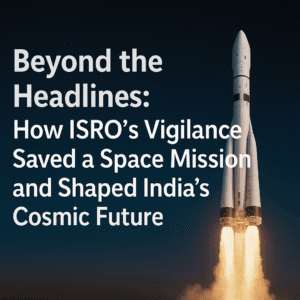Beyond the Headlines: How ISRO’s Vigilance Saved a Space Mission and Shaped India’s Cosmic Future
ISRO’s intervention proved critical for the Axiom-4 mission’s safety. Weeks before launch, an Indian team embedded with NASA insisted on deeper checks despite a perceived minor oxygen leak being dismissed. Their vigilance revealed a dangerous crack in the rocket’s vital oxidiser line – a potentially catastrophic flaw for the crewed mission. This crucial discovery forced repairs, preventing disaster. Beyond averting crisis, ISRO Chairman Dr. Narayanan emphasized the mission served as an invaluable operational blueprint for India’s human spaceflight ambitions (Gaganyaan).
Indian scientists gained firsthand experience in crewed mission management at NASA’s launch and control centers, learning from veteran astronauts. Astronaut Shubhanshu Shukla’s documented experiences in space and return will directly inform training for India’s future astronauts and its planned space station. This episode highlights ISRO’s growing safety expertise and the strategic value of international collaboration for India’s cosmic future.

Beyond the Headlines: How ISRO’s Vigilance Saved a Space Mission and Shaped India’s Cosmic Future
The successful launch of Axiom-4 on June 25th, carrying Indian astronaut Group Captain Shubhanshu Shukla to the ISS, masked a critical moment where disaster was narrowly averted – thanks to the persistent intervention of an ISRO team. As revealed by ISRO Chairman Dr. V Narayanan, this episode wasn’t just about fixing a rocket; it was a masterclass in safety, international collaboration, and a significant leap for India’s human spaceflight ambitions.
The Near-Miss Before Liftoff:
Weeks before the triumphant launch, the mission faced repeated delays. An initial electrical issue pushed the launch from May 29th to June 8th. On that day, during a crucial engine test-fire, two problems emerged:
- An anomaly in a thrust-direction actuator.
- A perceived “minor” oxygen leak.
While the leak was initially dismissed by some as inconsequential, the embedded team of 18 ISRO scientists, including Dr. Narayanan and the Director of the Human Space Flight Centre, sensed something was amiss. Their experience and intuition clashed with the prevailing assessment.
The Crucial Intervention:
“The Indian team insisted that proper checks be carried out even if it meant delaying the mission,” Dr. Narayanan emphasized. This insistence on rigorous safety, prioritizing caution over schedule, proved pivotal. Further, intensive inspections revealed the true danger: a crack in the rocket’s oxidiser line.
This wasn’t a minor leak; it was a critical structural flaw. The oxidiser line carries the liquid oxygen vital for powering the rocket. A failure in flight, especially on a crewed mission carrying human lives, could have been catastrophic. ISRO’s vigilance forced the repair, resolving a potentially life-threatening issue hidden beneath the surface of the initial diagnosis.
More Than Just a Fix: A Classroom in the Cosmos
Beyond the critical hardware save, Dr. Narayanan highlighted the Axiom-4 mission as an invaluable learning platform for India’s nascent human spaceflight program (Gaganyaan). The ISRO team wasn’t just observers; they were embedded at the heart of operations:
- At Kennedy Space Center: Witnessing launch preparations and countdown protocols firsthand.
- At Houston Mission Control: Immersed in real-time flight operations – monitoring astronaut health, managing communications, interpreting complex telemetry data, and participating in contingency planning.
- Learning from Legends: Observing the training and expertise of veteran astronauts like mission commander Peggy Whitson provided unparalleled insights into preparing humans for the extreme environment of space.
“This was like a classroom,” Dr. Narayanan stated, underscoring the operational knowledge gained. “The experience was important for understanding how human space missions are run at an operational level… The training of the astronaut… was a big learning experience.”
Building India’s Cosmic Future:
The lessons extend far beyond the Axiom-4 mission. Group Captain Shukla’s experience – living in microgravity, coping with isolation, and the process of returning to Earth – is being meticulously documented at ISRO’s request. This firsthand account will become “teaching material” for India’s future astronaut corps, shaping the training for the ambitious goals of an Indian space station by 2035 and a human Moon mission by 2040.
The Human Insight:
This story transcends a technical fix. It reveals:
- The Unseen Value of Vigilance: In high-stakes endeavors like spaceflight, experience, intuition, and the courage to challenge assumptions – even within a collaborative environment – are paramount. ISRO’s team demonstrated that safety must always override schedule pressure.
- The Power of Embedded Learning: India didn’t just send an astronaut; it sent a team of future mission controllers and program leaders. Their deep immersion in NASA’s operational culture provides a practical blueprint impossible to replicate solely through simulations or textbooks.
- Foundations for Ambition: Every detail learned, from fixing a cracked line to managing astronaut reconditioning post-flight, directly feeds into the credibility and capability of India’s Gaganyaan program and its audacious long-term vision. Shukla’s documented experiences become a uniquely Indian knowledge base for future spacefarers.
The crack in the oxidiser line was a physical flaw, but its detection and repair symbolize a deeper strength: India’s growing capability, its commitment to safety, and its strategic investment in learning from global partners. This intervention wasn’t just about ensuring one launch; it was a critical step in launching India’s own sustained human presence in space.
You must be logged in to post a comment.